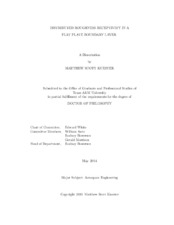| dc.description.abstract | Surface roughness can affect boundary layer transition by acting as a receptivity mechanism for transient growth. Several experiments have investigated transient growth created by discrete roughness elements; however, very few experiments have studied transient growth initiated by distributed surface roughness. Some of the work in this field predicts a "shielding" effect, where smaller distributed roughness displaces the boundary layer away from the wall and shields larger roughness peaks from the incoming boundary layer.
This dissertation describes an experiment specifically designed to study the shielding effect. Three roughness configurations, a deterministic distributed roughness patch, a slanted rectangle, and the combination of the two, were manufactured using rapid prototyping and installed flush with the wall in a flat plate boundary layer. The main objective was to compare the wakes of the discrete roughness and the combined roughness to examine if the distributed roughness shields the discrete roughness. Naphthalene flow visualization and hotwire anemometry were used to characterize
the boundary layer in the wakes of the different roughness configurations.
For roughness Reynolds numbers (Re_(k)) between 113 and 230, the distributed roughness initiated small amplitude disturbances that underwent transient growth. The discrete roughness element created a pair of high- and low-speed streaks in the boundary layer at a sub-critical Reynolds number (Re_(k) = 151). At a higher Reynolds number (Re_(k) = 220), the discrete element created a turbulent wedge 15 boundary layer thicknesses downstream.
When the distributed roughness was added around the discrete roughness, the wake amplitude decreased at the sub-critical Reynolds number, and transition was delayed by two boundary layer thicknesses at the higher Reynolds number. The distributed roughness redirects energy from longer spanwise wavelength modes to shorter spanwise wavelength modes. The presence of the distributed roughness also decreased the growth rate of secondary instabilities in the roughness wake.
This dissertation documents the first detailed measurements of transient growth over streamwise-extended distributed roughness and demonstrates that the shielding effect has the potential to delay roughness-induced transition. The results from this experiment lay the ground work for future studies of roughness receptivity and transient growth. | en |


